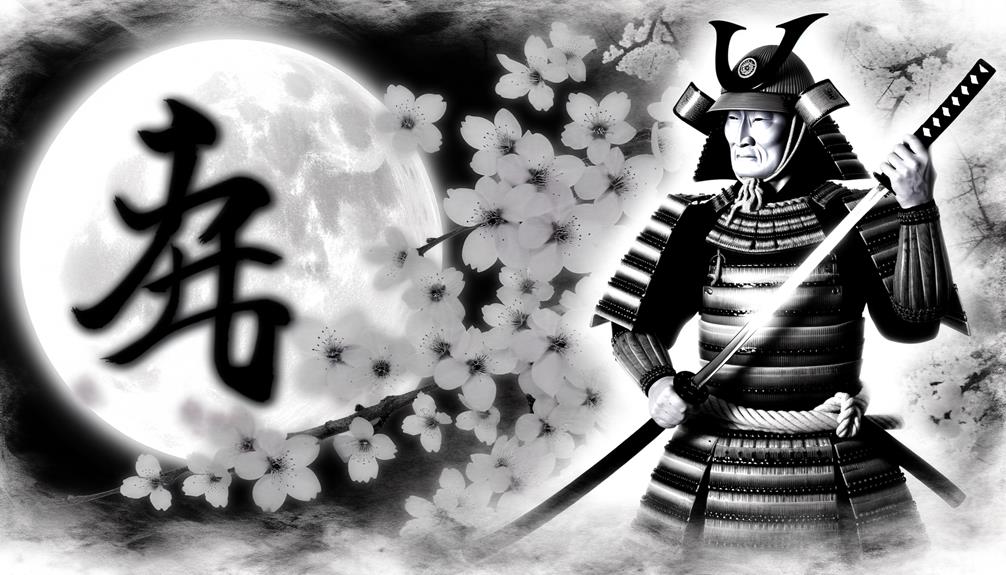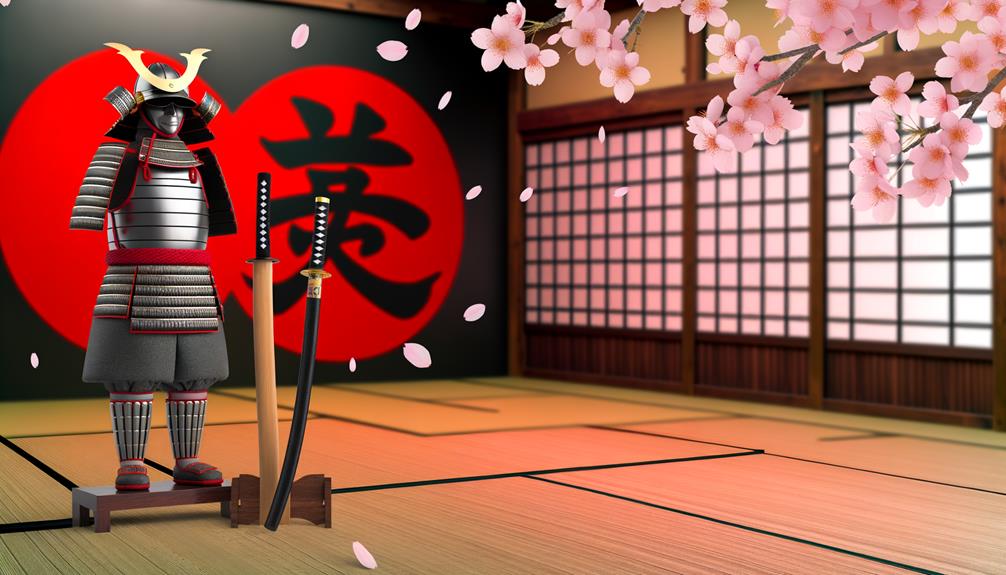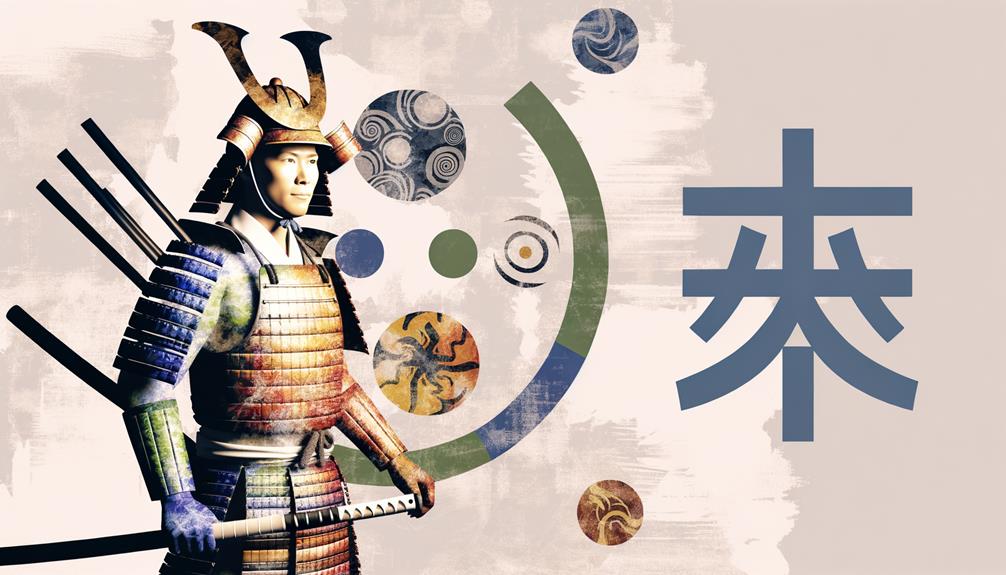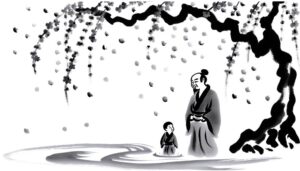What Does the Japanese Warrior Way Symbol Mean in Culture?
The 'Way of the Warrior' or Bushido, illustrated through specific Japanese symbols, encapsulates a distinct ethical code rooted in feudal Japan. Bushido synthesizes Buddhist, Shinto, and Confucian principles, emphasizing virtues like Rectitude, Courage, and Honor.
Symbols such as the katana, representing the samurai's soul, and motifs in art like the chrysanthemum, reflect this moral framework. These symbols are not merely decorative but embody the disciplined, loyal, and ethical conduct expected of samurai.
Contemporary interpretations continue to evolve, blending traditional values with modern contexts. Understanding these symbols offers deeper insights into the enduring legacy of Bushido.

Key Takeaways
- The katana symbolizes the samurai's soul and ethical commitment central to Bushido.
- The chrysanthemum represents the virtues of loyalty and honor in samurai culture.
- Dragonflies are emblematic of courage and strength, reflecting the warrior spirit.
- Kanji characters often depict key Bushido principles like Rectitude, Courage, and Respect.
- Artistic expressions like Noh masks and ink paintings visually narrate the disciplined life of the samurai.
Origins of Bushido

The origins of Bushido, the moral code of the samurai class in feudal Japan, can be traced back to a synthesis of Buddhist, Shinto, and Confucian principles that began to coalesce during the Heian period (794-1185).
This amalgamation was not instantaneous; rather, it evolved as societal needs and philosophical influences intersected. Buddhism introduced concepts of self-discipline and the transient nature of life, while Shinto emphasized loyalty to one's lord and reverence for ancestors. Confucianism contributed the virtues of filial piety and social harmony.
Together, these elements forged a distinct ethical framework that guided the samurai in their duties and personal conduct, laying the groundwork for what would become known as Bushido in later centuries.
Core Principles
Building upon this rich tapestry of philosophical influences, the core principles of Bushido crystallized into a codified set of virtues that governed the behavior and ethos of the samurai. These principles extended beyond mere martial prowess, embedding ethical and moral directives that were to be upheld in all aspects of life. The virtues included Rectitude, Courage, Benevolence, Respect, Honesty, Honor, and Loyalty. Each principle was not merely a guideline but a mandate that shaped the very identity of the samurai.
| Principle | Description |
|---|---|
| Rectitude | Adherence to moral conduct |
| Courage | Boldness to face danger and adversity |
| Benevolence | Act of kindness and generosity |
This codification guaranteed a disciplined and honorable path in both personal and communal spheres.
Samurai and Bushido

Integral to the ethos of the samurai, Bushido emerged as an all-encompassing moral framework that dictated every facet of their lives, from their conduct in battle to their personal interactions and societal obligations. Rooted in principles such as loyalty, honor, and self-discipline, Bushido shaped the samurai's identity, demanding both martial prowess and ethical integrity.
The philosophy was not merely an ideal but a lived reality, influencing legal codes, education, and governance. Bushido's emphasis on duty and sacrifice underscored a samurai's unwavering commitment to their lord and community, fostering a culture of resilience and respect. This intricate moral code served as the backbone of samurai culture, ensuring that their actions consistently reflected the high standards of their revered warrior class.
Symbolism in Art
Japanese art, with its profound use of symbolism, serves as a rich tapestry through which the values and ideals of the samurai are vividly expressed. The samurai's code, known as Bushido, is often represented through motifs such as the chrysanthemum, symbolizing honor, and the dragonfly, denoting courage and agility. Ink paintings, woodblock prints, and Noh masks often depict these elements, intertwining aesthetic beauty with philosophical depth.
The katana, more than a weapon, is frequently illustrated to signify the warrior's soul and ethical commitment. Such artistic expressions function not merely as decorative items but as visual narratives that encapsulate the disciplined life, virtues, and spiritual essence of the samurai, offering a profound insight into their world.
Modern Interpretations

Contemporary interpretations of Bushido and samurai symbolism often blend traditional motifs with modern artistic mediums, creating a dynamic fusion that resonates with today's cultural and aesthetic sensibilities.
This fusion is evident in various forms such as digital art, fashion, and film, where the essence of the samurai code is reimagined to reflect contemporary values. Artists and designers incorporate elements like kanji characters and samurai imagery into their works, providing a bridge between historical reverence and modern innovation.
This blending not only preserves the philosophical tenets of Bushido but also reinvigorates them, making them accessible and relevant to a global audience. By doing so, modern interpretations make certain that the spirit of the samurai continues to inspire and evolve.
Bushido in Business
Building upon the fusion of traditional and contemporary interpretations, the principles of Bushido have found a unique application in modern business environments, where they serve as a guiding framework for leadership, ethics, and organizational culture.
Emphasizing virtues such as integrity, respect, and loyalty, Bushido influences decision-making processes, fostering a culture of accountability and trust. Leaders who embody these values can inspire dedication and enhance team cohesion.
Moreover, the emphasis on continuous self-improvement and resilience aligns with modern business strategies focused on innovation and adaptability. By integrating Bushido, companies can navigate ethical dilemmas and competitive markets more effectively, ensuring sustained growth and a positive corporate reputation.
This synthesis of ancient wisdom and contemporary practice offers a robust blueprint for ethical and effective business management.
Global Influence

Across diverse cultures and industries, the principles of Bushido have transcended their historical origins to exert a profound influence on global leadership paradigms and organizational ethics.
Rooted in virtues such as loyalty, integrity, and respect, these principles resonate within modern frameworks of ethical leadership and corporate governance. Companies worldwide adopt Bushido-inspired practices to foster environments of trust and accountability, effectively bridging Eastern philosophical tenets with Western corporate methodologies.
In the domain of international relations and diplomacy, Bushido's emphasis on honor and duty informs the conduct and negotiation strategies of statesmen. Through its integration into educational curricula and leadership training programs, Bushido perpetuates a global ethos of disciplined, principled action, reinforcing its enduring relevance in contemporary society.
Personal Applications
In the domain of personal growth and self-improvement, the principles of Bushido serve as a robust framework for cultivating discipline, resilience, and ethical integrity. Adherents of Bushido can integrate its core virtues—such as righteousness, courage, benevolence, respect, honesty, honor, and loyalty—into daily life to foster a well-rounded character.
This ancient code offers practical applications like enhancing decision-making processes through a lens of moral clarity and developing mental fortitude in the face of adversity. By internalizing Bushido, individuals can achieve a balanced approach to challenges, promoting both personal and professional excellence.
The continual practice of these principles not only aids in self-improvement but also in contributing positively to society.
Conclusion
Bushido, the way of the warrior, transcends its historical origins to permeate various facets of contemporary life, from art to business.
This ancient code's core principles have been romanticized and adapted, influencing global cultures and personal ethos alike.
The immutable essence of Bushido serves as a lodestar, guiding ethical conduct and decision-making processes.
The hyperbolic reverence for this age-old wisdom underscores its enduring relevance and transformative power in shaping modern societal norms and individual virtues.





